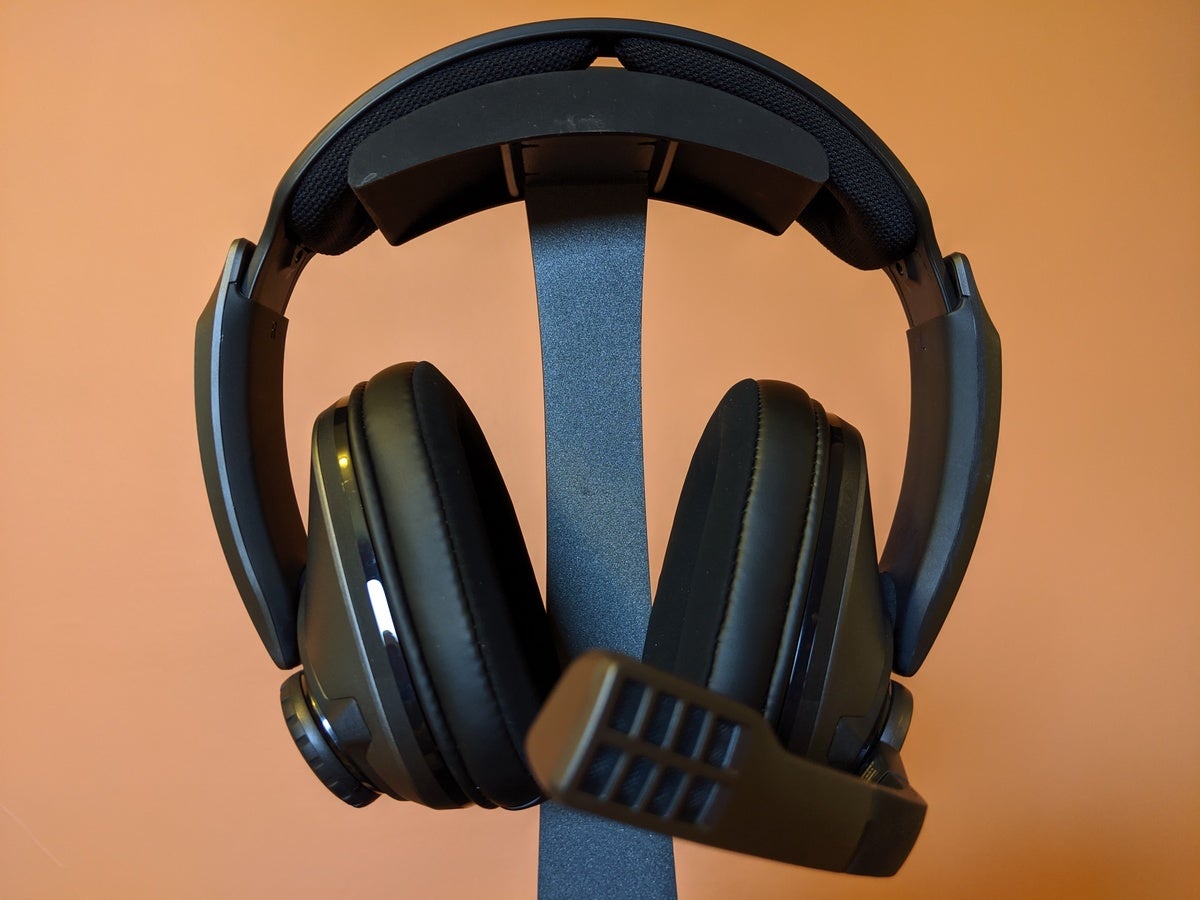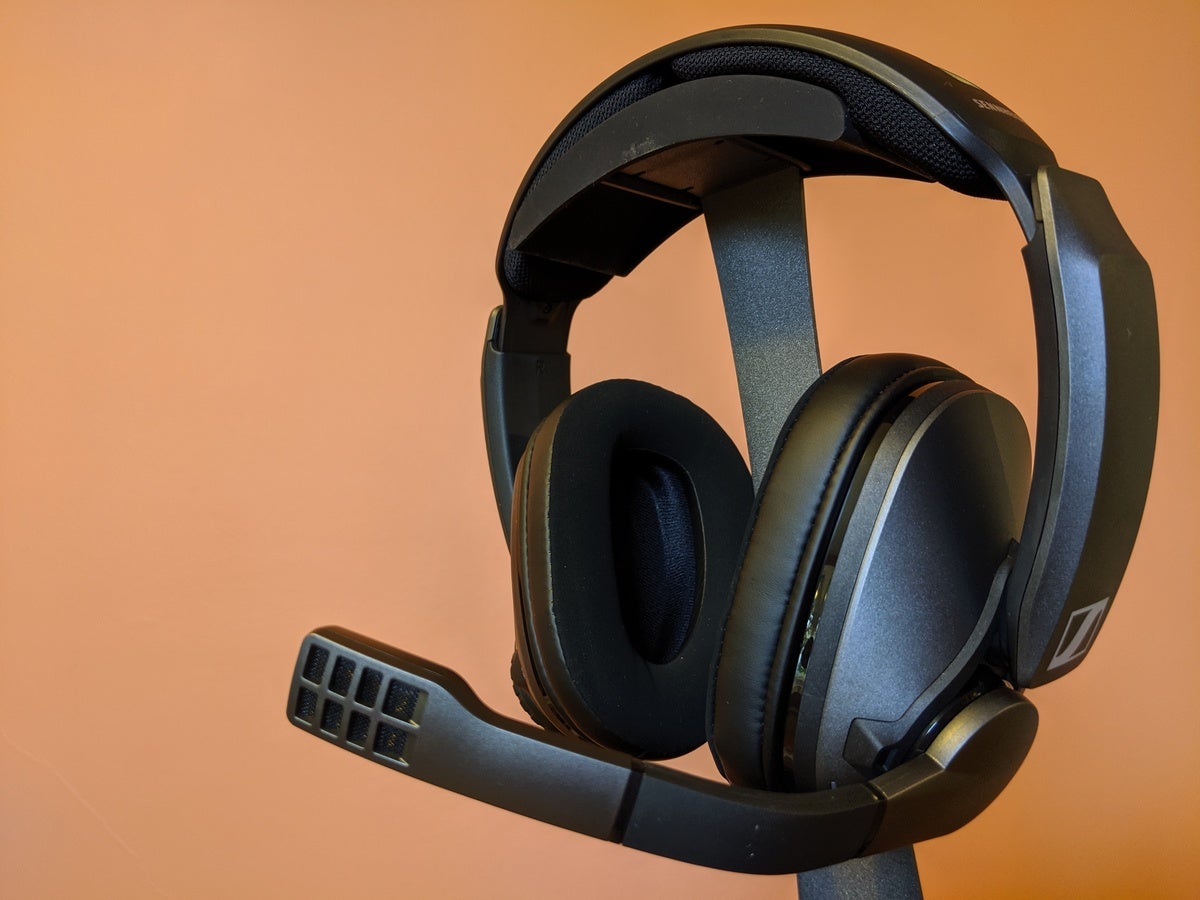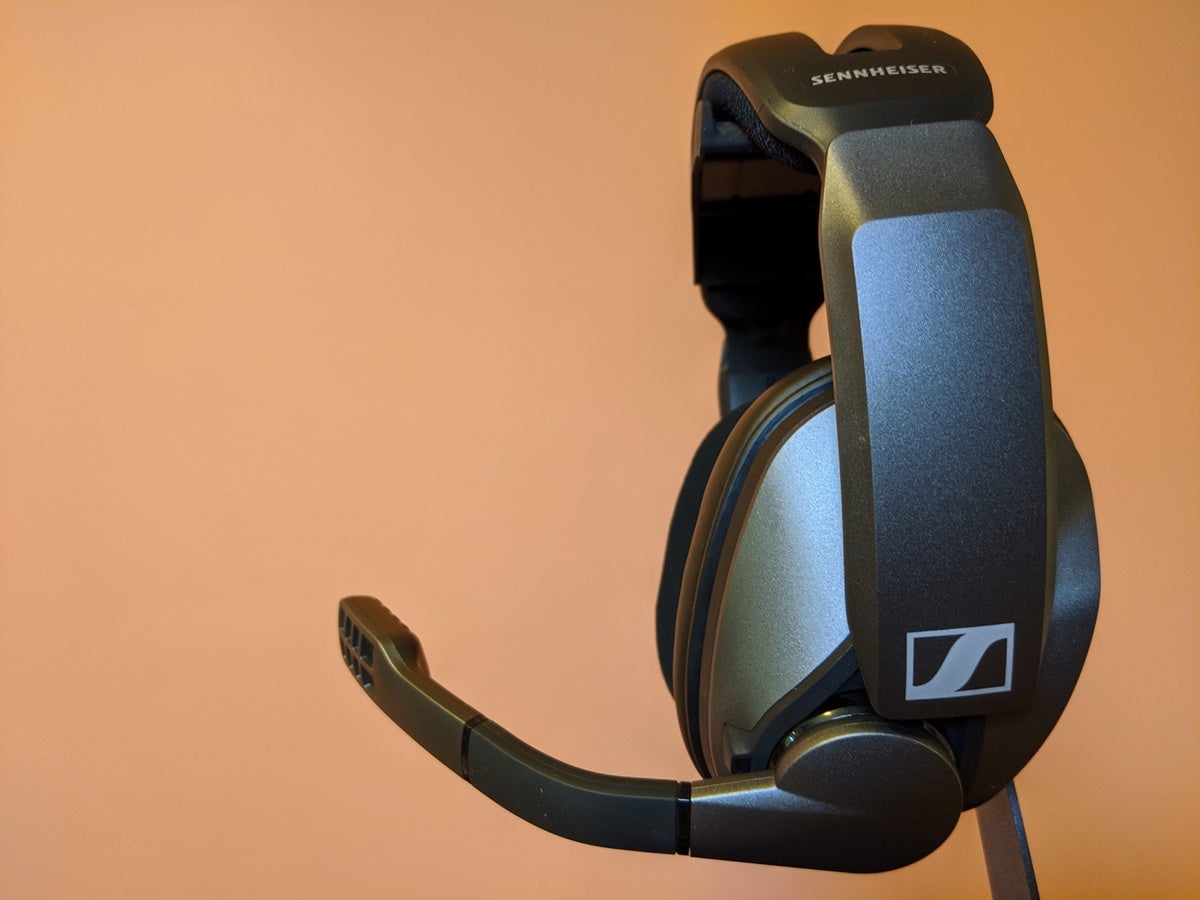The battery lasts for 100 hours. That’s all Sennheiser needed to say to pique my interest in the GSP 370. Charging various wireless devices is the bane of my existence, and I’m constantly looking for ways to mitigate the problem. Some are creative, like Astro’s A50 headset and its unique charging stand. But I’m all for Sennheiser brute-forcing the problem and just cramming a whopping big battery inside.
Whatever gets the job done, right?
Note: This review is part of our roundup of best gaming headsets. Go there for details on competing products and how we tested them.
Boxcar racer
And surprisingly, a whopping big battery doesn’t mean a whopping big headset.
Listen, the GSP 370 is by no means small. Sennheiser’s gaming headsets tend to be boxy, with more than a hint of the dreaded “Air Traffic Control” silhouette, and the GSP 370 is no exception. But it also isn’t noticeably larger than Sennheiser’s previous efforts like the GSP 600 we reviewed earlier this year.
 IDG / Hayden Dingman
IDG / Hayden DingmanNor is it heavier. Quite the contrary. The GSP 370 is shockingly light, weighing in at a mere 0.62 pounds. That’s less than both the Astro A50 and Logitech G Pro X, which weigh in at 0.83 and 0.70 pounds, respectively. Larger batteries usually mean heavier headsets, but Sennheiser has kept the GSP 370 fairly trim.
Unfortunately, it’s done so (at least in part) by compromising on build quality. The GSP 370 is plastic to its core—plastic headband, plastic joints, plastic earcups, plastic microphone sheathe. You get the idea.
Plastic is wonderful in that it’s both lightweight and relatively durable. It doesn’t exude “luxury” like other materials though. Does that matter? Objectively, no. Subjectively? Well…it’s a $200 headset. That’s not the absolute pinnacle of wealth but it is on the higher end for a gaming headset nowadays, and the GSP 370 looks underwhelming next to peers like the Corsair Virtuoso RGB and the aforementioned Logitech G Pro X.
That said, comfort is surprisingly good. I say “surprisingly” because the GSP 370 seems spartan at first glance. There’s a scant half-inch of padding on the headband, and the same around the ears. Donning the headset, I expected my cartilage to press against the GSP 370’s drivers.
But its looks are deceptive. The GSP 370’s drivers are recessed deep into the plastic frame, so the earcups are almost twice as deep as the exterior indicates.
 IDG / Hayden Dingman
IDG / Hayden DingmanI don’t know why Sennheiser settled on that design but it works. I complained that the GSP 600 held my head in a vice grip, even after I played with its proprietary “contact pressure” adjustment sliders. The GSP 370 needs a short break-in period—give it a few good flexes—but after that you get an excellent seal without any unnecessary squeezing. Passive noise cancellation is top-notch, and while my ears did get a bit warm with prolonged use, I was still pretty impressed by the fit.
As for the built-in controls, Sennheiser had an easy time of it. The wired GSP models already included a flip-to-mute microphone on the left ear and a volume knob surreptitiously built into the right ear. The GSP 370 duplicates those elements, adding only a MicroUSB charging port and a power toggle on the bottom of the left ear. The power toggle is a bit small and finicky, but whatever, you only have to touch it once or twice a day.
Oh, and there’s an RGB LED power indicator on the left face, right below the microphone. It’s a gaming headset, and don’t you forget it. (Kidding, mostly. The LED turns off after a few seconds.)
Audiophiles assemble
Per usual, Sennheiser’s built a cheap-looking headset that sounds great. Consistency where it matters, I guess.
The GSP 370, like the GSP 600, is on-par with comparably priced Sennheiser headphones. The tuning is different, as Sennheiser tends to give its gaming headsets a bit of a mid-range boost, the better for making certain sounds like gunshots and dialogue pop. But it’s not as overbearing as the high-end boosts applied to Corsair’s headsets, and I find Sennheiser’s default sound listenable across music, games, and movies.
And the GSP 370 is the first Sennheiser headset we’ve reviewed in a while that connects through USB. That means it’s easy to rectify one of the more obvious issues, which is the lack of bass presence. Sennheiser’s bass implementation is very clean and precise, but lacks the oomph some might want when gaming. Luckily Sennheiser added a five-band EQ to its software since last time we tested it, making it easy to add a bit more low-end without damaging the overall clarity. It’s a welcome addition, and I eventually settled on a 3dB increase in the 80Hz band and a 2dB increase in the 300Hz band.
 IDG / Hayden Dingman
IDG / Hayden DingmanI’d stay away from Sennheiser’s EQ presets though. Both the “Music” and “Movie” presets significantly increase the treble (or “scooping the mids” in guitarist parlance), which ends up sounding like a telephone to my ears.
Sennheiser’s 7.1 functionality leaves a lot to be desired as well, crushing the GSP 370’s wide 2.0 soundstage in service of a crummy-sounding faux-surround. Sennheiser is unrivaled when it comes to crafting a beautiful stereo environment, especially as far as gaming headsets are concerned, so I’d stick to that and consider the 7.1 forgotten.
There’s also a software tab for the microphone. Reviewing the GSP 600, I commended Sennheiser for making a microphone that was “crisp, clean, and flattering even without the software tricks most USB-powered headsets lean on.” Turns out, those software tricks can make a great mic even better. I didn’t notice much difference between the default recordings and the “Warm” or “Clear” voice enhancers, but the addition of a noise gate can be extremely helpful in even moderately noisy environments. I was able to dial in the GSP 370 to cut any and all keyboard noise, something I’m sure my teammates appreciate.
Live long and prosper
Lastly, the vaunted 100-hour battery life. What can I say? It’s almost impossible to test that number with any real degree of certainty. Hell, I have trouble verifying claims of 20-to-30 hour batteries. Anything longer than a day strikes me as “Pretty solid,” especially given that use rarely lasts for an entire day straight. People usually take the headset off occasionally, or sit with it on but silent, and so forth.
The best I can say for the GSP 370 is that it lasts a long time. Like, a really long time. Theoretically the battery indicator in Sennheiser’s software should drop one percent per hour, but even that isn’t consistent. I’ve gone upwards of a week without charging it, or even getting to that “Hmm, I should think about charging this” stage.
 IDG / Hayden Dingman
IDG / Hayden DingmanMy only concern is that because the battery lasts so long, when it does die it’ll inevitably take you by surprise. When you get in the habit of plugging in your headset every night—or in the case of the A50, setting it on the charging stand—you’re always certain it’s ready to go. The GSP 370 won’t engender those same habits.
When that is my biggest concern, however, you can surmise that I have no complaints. Hopefully others can follow Sennheiser’s lead, because the bar for battery life was just raised significantly.
Bottom line
End of the day, I still wish Sennheiser would rethink its design language. Boring, boxy, and corporate. These are the charges I’ve leveled at the GSP line for years now, and nothing’s changed. Sennheiser’s certainly got the audio chops to challenge Corsair, Razer, and even Logitech. But the GSP line is bland, if not outright ugly, and a far cry from Sennheiser’s more mainstream headphones like the Momentum 3 or many of its HD-branded models—or even its alternative gaming headset, the all-but-abandoned Game Zero.
The GSP 370 scores major points for its battery life. Hell, it’s a minor miracle. And it sounds great too! I only wish the aspects I liked came in a more attractive package. Alas, maybe next time.
This story, “Sennheiser GSP 370 review: A wireless headset that lasts for 100 hours—that’s all you need to know” was originally published by

